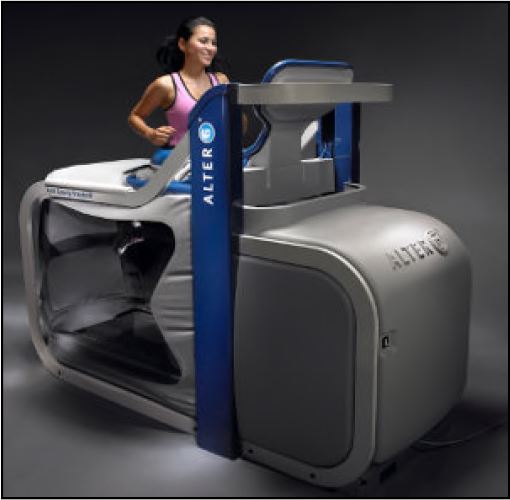by
Community Outreach and Philanthropy, (928) 771-5686, released May 14, 2013
| Aug 30, 2013
Whether you’re recovering from orthopedic surgery, undergoing therapy to reduce the side effects of Parkinson’s disease, or preparing to run a marathon, Yavapai Regional Medical Center’s (YRMC’s) AlterG Anti-Gravity Treadmill may be in your future.
“The AlterG rehabilitation treadmill incorporates technology that was developed by NASA to help astronauts compensate for the effects of weightlessness in space,” said Rich Tenney, PT, DPT, PRC, Physical Therapist at YRMC.
Like many NASA innovations, the AlterG has applications beyond its original purpose. In the medical setting, the AlterG has become a major part of rehabilitation for a variety of conditions. The Quad Cities’ only AlterG was introduced recently at YRMC’s Wellness Center at YRMC West, 930 Division Street in Prescott.

“The Alter G can unload up to 80 percent of the patient’s body weight, simulating a gravity environment that is similar to walking on the moon’s surface,” Tenney said. “When you decrease the pull of gravity on the body, there’s less impact, tension and stress on the body’s joints and tissues when standing, walking or running. The AlterG offers our patients the opportunity to build muscle, increase their endurance and move without pain.”
How does the AlterG work? It uses differential air pressure to unload up to 80 percent of an individual’s body weight in precise 1 percent increments. Before this process begins, the patient dons a pair of comfortable shorts—similar to bicycle shorts—over his or her clothing. Next, the patient steps into the treadmill’s air chamber where the shorts are zipped to the casing. This creates an air-tight seal. Air then fills the chamber as it unloads the designated percentage of the patient’s body weight.
“The AlterG reduces the stress of weight on the body, similar to what we experience in pool therapy, but with less risk for infection,” Tenney said. “The AlterG also more closely matches the environment in which we live: air rather than water. I’ve seen a patient who had extreme difficulty walking with an assistive device, walking on her own—and without pain— while using the AlterG. It’s incredible.”
The AlterG enhances rehab after sports-related injuries such as tendonitis, ACL repairs, and total joint replacements. It can be used to treat people with balance and movement dysfunction resulting from stroke, Parkinson’s disease, or other neurologic disorders. The AlterG can also be used to decrease the pressure on the spine following back surgery. This allows the patient to rehab and build core strength with less pain and discomfort.
“For example, a patient may be able to walk or run on the AlterG without pain at 50 percent of their body weight,” said Tenney. “We work from this, gradually increasing the patient’s body weight on the AlterG until they can walk or run at 100 percent of their body weight without pain.”
Athletes also use the Alter G to reduce the frequency of injuries, improve their fitness and develop muscle coordination with less impact on the body. People interested in learning more about the AlterG Antigravity Treadmill may contact the YRMC Wellness Center at (928) 771-5131.